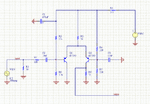zuzu
Member level 3

Hello friends,
Some kind stuck at this stage: sine to square converter (to feed some fpga).
I have a sine wave on 100 MHz with ~3Vrms and need to convert with low jitter to square 3v3.
I tried classic logic buffer with 74F04 (little offset-ed out of 1/2Vdd) 74AC04 (better results, more amplitude) and 74AC14 (best results so far). But the signal out from 74AC14 (all have the same problem) isn't square as it supposed to
It's a nice (amplified, clean) sine wave ~4.35Vrms.
Out from last inverter was protected by 47ohm series but no effect, seems not scope capacitance is the problem (I have a Yokogawa 5Gsps @ 500MHz). Maybe propagation delay of buffers is close to limit? But 74AC04 has specified 5nS with 50pF...
Any clues? Or should I just feed FPGA with sine, ac coupled? I am interested in jitter measurements so can (or is even better) to leave sine as is, no more converting?
Any advices greatly appreciated,
Some kind stuck at this stage: sine to square converter (to feed some fpga).
I have a sine wave on 100 MHz with ~3Vrms and need to convert with low jitter to square 3v3.
I tried classic logic buffer with 74F04 (little offset-ed out of 1/2Vdd) 74AC04 (better results, more amplitude) and 74AC14 (best results so far). But the signal out from 74AC14 (all have the same problem) isn't square as it supposed to
It's a nice (amplified, clean) sine wave ~4.35Vrms.
Out from last inverter was protected by 47ohm series but no effect, seems not scope capacitance is the problem (I have a Yokogawa 5Gsps @ 500MHz). Maybe propagation delay of buffers is close to limit? But 74AC04 has specified 5nS with 50pF...
Any clues? Or should I just feed FPGA with sine, ac coupled? I am interested in jitter measurements so can (or is even better) to leave sine as is, no more converting?
Any advices greatly appreciated,






